Co-Motion Co-Pilot Travel Case Video Review
At first glance, the Co-Motion Co-Pilot Travel Case looks like an ordinary suitcase you’d expect to see at any international airport. But in reality, the Co-Pilot Case is a special travel case designed specifically for use with Co-Motion Co-Pilot bicycles (or bicycles that have a frame fitted with S&S couplers).
The benefit, of course, to having an airline-friendly travel case and a bicycle that splits in half with S&S couplers is that you can travel with your bicycle and not have to pay extra baggage fees when you fly. With most airlines, your bicycle will fly for free if it fits inside the Co-Pilot Case! This is a huge benefit when you consider the fact that some airlines are now charging as much as $350 USD per direction to fly with a full size bicycle.
If you are unfamiliar with Co-Motion Cycles or the S&S couplers that allow you to safely and securely split a bicycle frame in half, be sure to read my detailed review of the Co-Motion Pangea touring bicycle. I talk at great length about the S&S couplers, how they work, and the benefits of riding a bicycle fitted with these unique features.
In this article, however, I will be discussing only the Co-Pilot Case, which is an optional accessory that can be purchased for any single or tandem Co-Motion bicycle fitted with S&S couplers.
The Co-Pilot Travel Case: Basic Information & Measurements
The Co-Pilot Case is a black and slate blue (I would call it dark, dark blue) suitcase that has been designed specifically for use with Co-Motion Co-Pilot bicycles.
The Case looks like an ordinary suitcase, but it has some unique characteristics that set it apart from your typical travel luggage. You would not, for example, be able to purchase a similarly sized suitcase at your local travel/luggage store and be able to fit your bicycle inside of it. It simply wouldn’t fit because the Co-Pilot Case has been designed to have more interior space than your typical suitcase. This extra interior space is what allows you to easily carry your bike inside the Case when traveling.
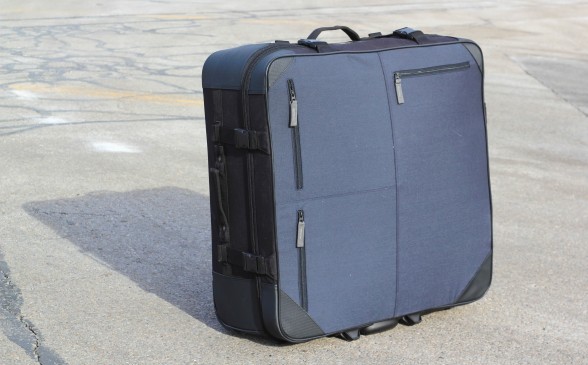
The Co-Pilot Travel Case measures 26 inches wide by 26 inches tall and has a depth of just 10 inches. The total measurements of the Case are therefore 62 linear inches, which is the maximum that most airlines allow travelers to bring with them under the free baggage requirements.
The Co-Pilot Case weights approximately 17 pounds with nothing inside it. But when a bicycle is packed up inside the Case, the weight increases to 48 or 49 pounds (once again, just under the 50 pound maximum allowed by most airlines). Of course, the weight of your loaded Case will vary depending on which bicycle you use and what additional accessories you decide to carry inside the Case while you are traveling (i.e. racks, fenders, water bottles, pedals, bike tools, etc).
On the front of the Case are three exterior pockets, which can be used to store thin, flat items or documents/paper (but very little else).
On the backside of the Case is a zipper which hides a large telescoping Pullman handle, which can be easily extracted from the Case, making it easy to push, pull, or roll the Case along the ground when fully loaded.
At the top of the Case there is also a small name tag window that can be used to show off your name and contact information, should your bicycle get lost or misplaced during transport.
Finally, a heavy-duty zipper is used to secure your bicycle inside the Case and six additional webbing straps surround the bag’s contents, helping to ensure you won’t lose a thing when your bicycle is in transport.
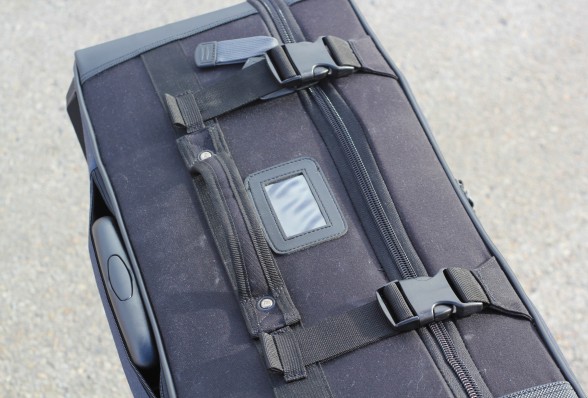

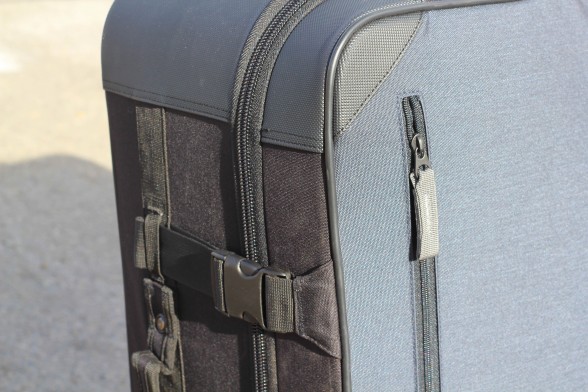
How do you fit your bicycle inside the Co-Pilot Case?
Watch the video at the top of this page to see how a bicycle fitted with S&S couplers fits inside the Co-Pilot Travel Case.
In order to travel with a bicycle inside the Co-Pilot Travel Case, you first need to remove the bicycle’s front and rear racks, water bottle cages, fenders, handlebars and pedals. Then deflate the air from both tires and unscrew the custom Co-Motion cable splitters found on the three main cables that run along the bottom tube of the bicycle. After that, use the S&S coupler wrench, which is included with your Co-Motion bicycle, to carefully split the frame of the bike in half. Just twist the coupler’s outer casing in a counter-clockwise fashion and the bicycle will easily split apart. Depending on the size of your bicycle’s frame, you may also need to remove your bicycle’s rear derailleur and/or the front fork from the rest of the frame.
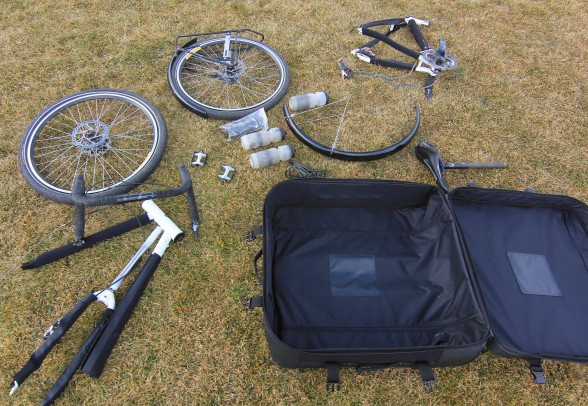
Then comes the tricky part. With your bicycle now in pieces, arrange the bicycle inside the Travel Case so that the five main parts of the bicycle (the two wheels, the handlebars and the two major parts of the frame) fit inside the Case.
Start by laying the front half of the bicycle’s frame down on the bottom of the Case and after removing the axles from both wheels, place the rear wheel down in the bottom of the Case, sliding the handlebars behind and under the gap of the rear wheel at the top of the Case. Then place the rear half of the bicycle on top of the rear wheel and slide the front fork into the gap between the frame where the rear wheel is usually found. (Once again, watch the video above to see how this is done.)
To finish packing the bicycle inside the Case, simply place the front wheel on top of all the other parts and slide the saddle, seat post, water bottles, fenders, racks and other miscellaneous parts into the gaps surrounding the bicycle. Then zip up the Case and you’re done!
If you want to protect your bicycle’s frame from scratches, dents and dings during the travel process, consider wrapping your bicycle’s frame with padding from the Co-Motion Frame Padding Kit – another optional accessory from Co-Motion that costs $89 USD (at the time of this review).
Packing your bicycle inside the Co-Pilot Case is not a quick process, nor is it necessarily easy the first time around. But after you’ve figured out how the bicycle fits inside the Case and you’ve gained some experiencing taking your bicycle apart and putting it back together again, the process really speeds up. Your first time packing or unpacking the bicycle might take as long as two hours. But after that you should be able to pack and unpack from your bicycle from the Case in about an hour’s time.
How much does the Co-Pilot Travel Case cost?
The Co-Pilot Travel Case costs $395 USD (at the time of this review). It is, therefore, not an inexpensive add-on to your Co-Motion bicycle.
However, if you consider the fact that many airlines are now charging $150 (or as much as $350 USD) to fly one-way with a full size bicycle, purchasing the Co-Pilot Case could pay itself off after just one or two flights.
To order a Co-Pilot Travel Case, simply contact your local Co-Motion dealer or visit the Co-Motion website at www.co-motion.com and place your order online.
If you have any questions or comments about the Co-Pilot Case that I have not answered in this review, just leave a comment in the box below and I’ll respond as soon as I can.

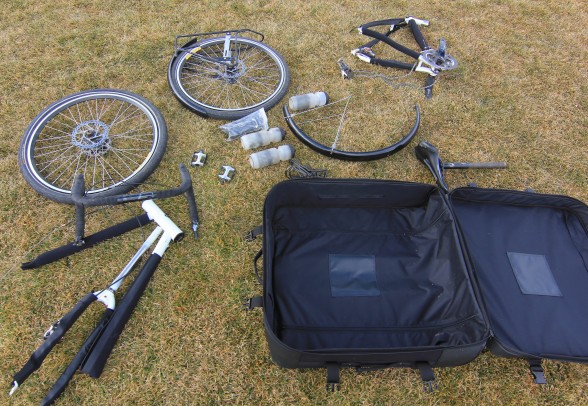
Intrigued how you fit the pannier carriers in. They’re not in the video?
The panniers don’t go in the case. The panniers (and everything that goes in them) are carried separately as your 2nd piece of checked baggage.
Omar, you are correct. This case is not collapsible. But in regards to using this case for your travels and what to do with the case when you are touring, please read this article: http://bicycletouringpro.com/what-to-do-with-your-bike-box-case-once-you-reach-your-bike-tours-starting-location/
Great review. I currently have the S&S hard case and find it very difficult to pack my 58cm Moots S&S coupled bike in it. The Co-Motion case looks easier to pack and the telescoping handle is a bonus. Question: is the soft sided case sufficiently rugged to protect the bike and especially the wheels? I travel with some pretty nice road wheels (Shimano c35s), so the trade off of ease of packing vs. protecting my gear is the cost/benefit risk I am trying to assess. I appreciate your thoughts on this point.
Someone commented that this case exceeds the maximum size limitation of 62 inches and they had to pay the oversized baggage fee. Can you comment on that based on your experience?
Thanks
Well, it’s hard to say exactly what happened, but it depends on which airline you are flying with. Some airlines may have different rules for the size of checked baggage. Sometimes you can stuff a regulation size bag to such a degree that it becomes oversize (which I’m guessing is what happened with the previous commenter). And sometimes you just get someone checking you in that is in a bad mood or is super anal about following regulations that they charge you extra for even the smallest infraction.
It usually come down to two factors when flying with a bicycle: 1. The size and shape of your bicycle baggage… and 2) The person who is checking your baggage in. Don’t get those two things right and you might end up paying extra to fly with your bike. But if you do your research, make sure your bag is under the size requirements, and you get someone who is going to be fair and rational with you at the check-in counter, then you should be able to fly your bike for free (as long as it is included with your free checked baggage allowance).
So just to be clear, you use the case in your travels, yes? Have you ever been charged excess baggage fees or does yours comply with the maximum 62″ regulation? I’m going to assume that most airlines will not charge the extra fee for bicycles provided the bikes fit in a case that complies with the maximum 62″ requirement.
That’s right. I have used the case on my travels and not had any problems. No airline has ever actually measured the case… and I’ve never been charged extra for flying with my Co-Motion bicycle when it is packed inside its official case. But again, this may differ depending on which airline you are flying, how you pack your bike (make sure the case isn’t bulging), and which person you get at the check-in counter.